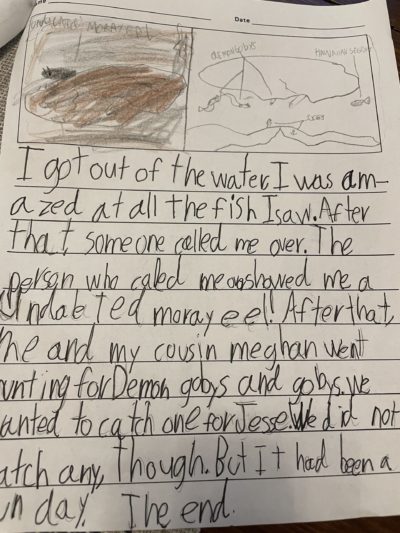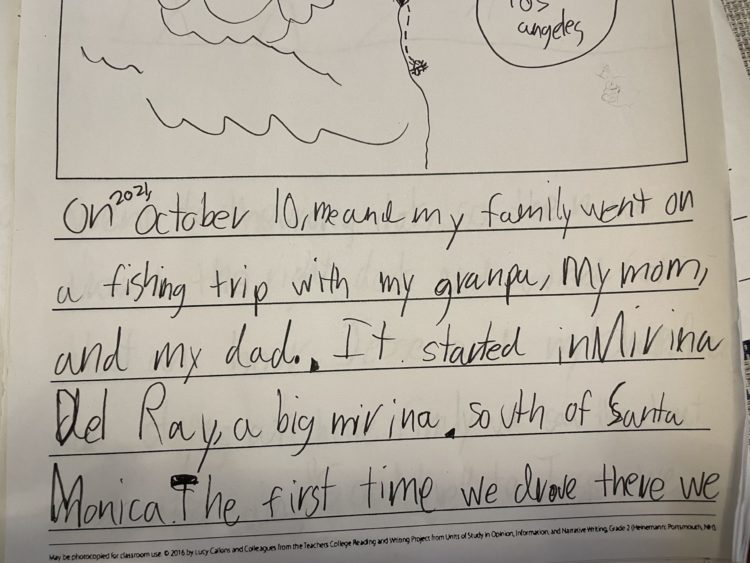Small-moment stories. That’s what the writers were laboring over the day I stepped onto the rainbow rug in my son’s third-grade classroom. I was there to share some of my work as a writer and to spend time with them as writers, punching up their stories. I’m a writer and a journalism professor, so it shouldn’t be too hard, right?
I had no idea.
I wound between neatly arranged beige tables and knelt beside each student. Most were quiet, heads down, laboring over letters, punctuation and dialogue. One boy was writing about a time he fell off his bike. He wrote about a Band-Aid his mom had applied and I whispered: “But how did it feel? “It burned when she put it on,” he said. Add that, I told him. That’s the kind of detail the readers love.
As a writer and journalism teacher, these are the sensory moments I want my students to include. But as adults, we get further from the raw emotions and immediacy of the story.
Another writer wrote about the time his cat scratched his eyeball — twice. The story opened with him looking for the feline, only to encounter her in the bathroom. “She made a sound, like when a tire is leaking air,” he wrote. My eyes popped open: such good metaphor and detail. When he wrote the dialogue of what it felt like getting scratched, his “OWWWWW!!!!” was punctuated by a waterfall of exclamation. I couldn’t hide my grin while reading.
The stories coming out of this little classroom of writers were all rooted in emotional truth, dialogue, characters and surprise — basically, everything I look for when I’m reading and strive for when I’m writing. And here they were at 8, writing about a time they went into a hot tub or learned to ride a horse. The practice of small-moment stories — which could be one-page essays, postcards or even Modern Love’s 100-word “Tiny Love Stories” — is valuable at any age.
The creativity of childhood
This kind of free-flowing personal writing wasn’t how I was taught in third grade. I remember learning the curve of a narrative arc — a beginning, middle and end — but also had years of spelling and punctuation tests. I have fond memories of index cards holding writing prompts, tucked into a small glass candy jar, like a treat to savor when the worksheets were done.

Formulaic ways of teaching writing — spelling tests or worksheets to fill in a missing word — ultimately underestimate the power of students’ thinking and writing, says Amy Lynch, who was my son’s first-grade teacher and now is a teacher and instructional coach in Wisconsin. “They have such interesting ways of saying things. They are sponges in terms of collecting phrases, but also being willing to invent their own.”
She says the writers workshop model — championed by Teachers College Reading and Writing and Project from Columbia University — capitalizes on what kids do naturally. “Everything is so new to them, so every small moment is interesting,” says Lynch. In this way of teaching, kids become writers even before they learn how to write: They are told, “You have something to say and we want to hear it.”
Many kids fall in love with writing because it feels like a craft project, like creating something out of a box, Lynch says: “Writing lends itself to a similar feeling, particularly for kids who like to express themselves.” The emphasis is less about spelling or grammar and more about detail, personality and voice.
Some of the kids in my son’s classroom had trouble narrowing their small moments down to a snapshot instead of writing about a whole day. But when they did, it seemed like a window into who they are as human beings. Lynch agrees. “It feels like magic when a 6-year-old can tell a story from a five-minute experience of missing the bus,” she says. “It’s like holy cow, I had no idea.”
***
Katharine Gammon is an award-winning independent science journalist based in Santa Monica, California. Her story interests range from culture and nature in public lands to the lives of scientists to the complexity of baby brains.



